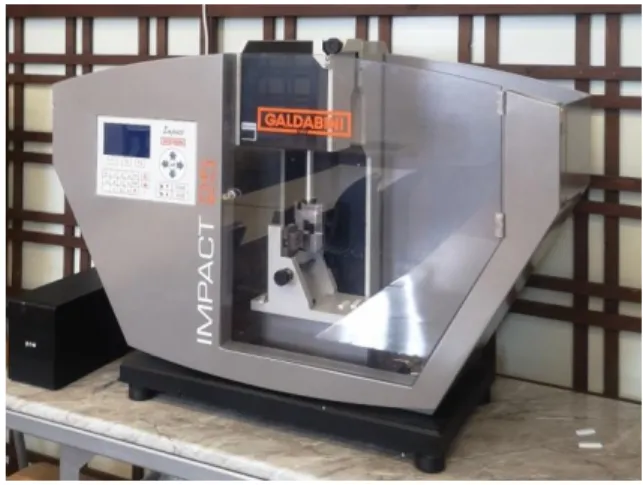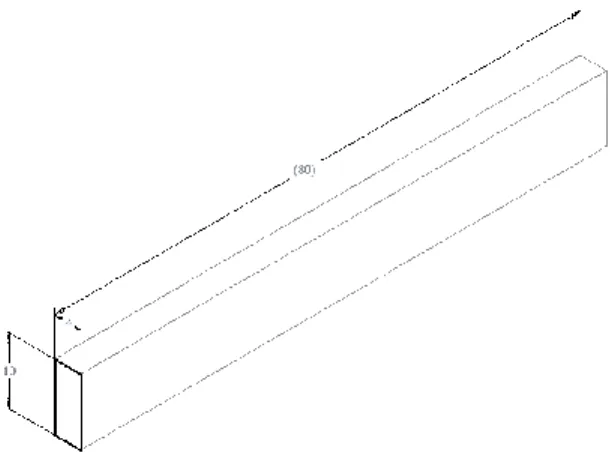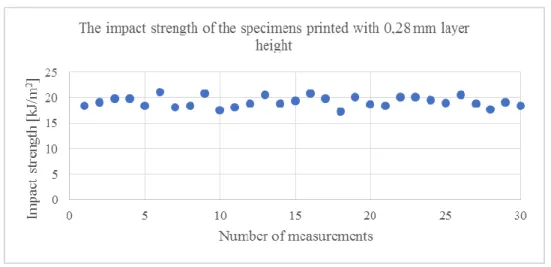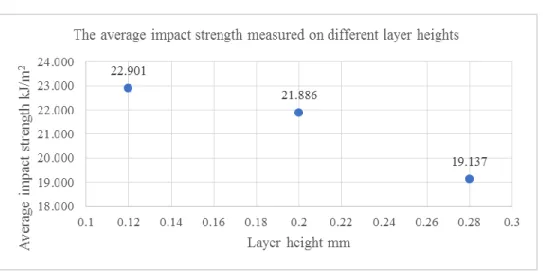INVESTIGATION OF LAYER HEIGHT INFLUENCING THE IMPACT STRENGTH OF POLYLACTIC ACID (PLA)
József Richárd Lennert, József Sárosi
Faculty of Engineering,University of Szeged, Mars tér 7. 6724, Szeged, Hungary e-mail: sarosi@mk.u-szeged.hu
ABSTRACT
The aim of this study is to investigate the effect of layer height used during 3D printing on the impact strength, their standard deviations, and the printing time by using UNI EN ISO 180 unnotched specimens manufactured by FDM 3D printing technology. Every specimen is made of PLA, which is the most basic material of the FDM printing technology by using the same 3D printer. In this study it plays a key role to find out whether the layer height can be used to optimize the researched mechanical property within an economical framework or not. What is more, the possibly observable tendencies and crucial influential parameters will be analysed as well.
Keywords: PLA, 3D printing, layer height, additive manufacturing, impact strength 1. INTRODUCTION
The additive manufacturing, which is often mentioned as 3D printing, is one of the most dynamic and intensive developing manufacturing technologies. 3D printing has many different types just like FDM (Fused Deposition Modelling), SLS (Selective Laser Sintering), and SLA (Stereolithography) [1], [2].
Besides, the 3D printers used to print different types of plastics. However, nowadays there are printers which are suitable to print different types of materials such as metals, ceramics, composites, concretes, and even biomaterials can be printed [2].It must be mentioned that 3D printers using materials different from plastic are used mostly for industrial and scientific purpose hence both the 3D printers and the 3D printing provided by the companies are too expensive for the average consumers Among the 3D printers, which are appropriate to print different types of plastics, the 3D printers using FDM technology are one of the most common and the cheapest ones [3]. Out of the many advantages of 3D printing, the most important one is that almost any kind of complex shapes can be created by using this technology hence it creates the object layer by layer. Therefore, zero or almost zero waste is produced during the process making this technology extraordinarily favourable from the point of view of a waste management. There are a lot of factors affecting 3D printing, but their effect on the mechanical properties is often not properly known for us. This will not cause any problems if the product is a prototype or is produced for a purpose in which it is not exposed to any kind of mechanical impacts.
However, the effects of the printing parameters on the mechanical properties become a key factor if the 3D printed product is any kind of replacement part.
Thanks to the industrial spread of this technology, more and more scientific articles are published in connection with the effect of printing parameters on the mechanical properties during the last few years.
Most of these scientific articles investigate their effects on tensile strength or yield strength [3], [4], [5].
Nevertheless, there are articles examining the printing parameters’ effects on the impact strength [6], [7].
These articles concerning the impact strength are mainly related to notched specimens due to the drastic impact strength reduction caused by the stress collector place on the object. In several studies, the effect of infill pattern, infill density, printing temperature, printing direction, layer height, print speed or other parameters on the impact strength was analysed [8], [9]. In every study it was proven that the examined mechanical properties were influenced by the parameters used during the printing, but the degree of influence was different relating to every single parameter [10].
2. MATERIALS AND METHODS
The Polylactic acid or PLA is a biodegradable, rigid thermoplastic produced mostly from different types of grains containing a huge amount of starch. In 3D printing, PLA is one of the most common materials especially for hobby hence it has not only a reasonable price, but it can be printed easily without a special printing area. For this reason, it is very easy to work with it without any experience in 3D printing. This material is used especially for producing disposable products over and above in 3D printing, to create prototypes and a huge variety of hobby products. Due to its biodegradability, PLA is extremely advantageous in terms of waste management. It is important to mention that the research made in different scientifical areas pointed out that 3D printed PLA could be often a better choice than traditional technical plastics such as ABS [11].
Thanks to the development of 3D printing technology, more and more special PLA is available on the market meaning that there can be a huge difference among the mechanical properties of the PLA filaments produced by different companies. Even ABS-like and flexible PLA can be found.
For the measurements, a Galdabini Impact 25 impact testing machine (Figure 1) was used. This precision measuring instrument makes it possible to measure to two decimal places and it gives the impact strength immediately in kJ/m2 if a standard specimen known by the machine is used preventing the faults caused by the calculation and reading errors and saving time.
This measuring instrument has only a 5 J hammer making it impossible to measure plastics specimen with higher impact strength. Despite the incorrect values caused by the low measuring limit, it is ideal to measure plastics like PLA. For the proper measurement of technical plastics like ABS, a bigger hammer would be necessary.
Figure 1. Galdabini Impact 25 impact testing machine
For the measurement UNI EN ISO 180 standard unnotched specimens were used (Figure 2), whose dimensions are 80×10×4 mm. This type of specimens was chosen, because it is known by the Galdabini Impact 25 impact testing machine making the work more precise and faster. The unnotched type was chosen because the manufacturers test their material by using notched specimens. Nevertheless, in some cases, there is no stress collector on the product causing oversizing and unnecessary material usage if the
Figure 2. The model of specimen used for the measurements
The measurements were done in every case at room temperature to make possible comparisons of the results in the future. Before the measuring process every specimen was kept under such circumstances for a minimum time of 24 hours. During the measuring process, the specimen supported at both ends was hit in the middle by the hammer of the Charpy breaking the specimens and making it possible to determine the value of impact strength correctly.
The essential Gcodes for the printing were created by the software Ultimaker Cura 4.4 allowing the modification of a huge amount of 3D printing parameters. The Gcodes with different layer height were made by using this software.
The 3D printed PLA specimens were produced by using a Creality CR-10S Pro V2 3D printer. This printer provides a very reliable printing due to its built-in filament break detection module and self-levelling. Due to its excellent printing quality and favourable price, this 3D printer is one of the best middle class FDM printers on the market.
For the printing, 3DJake EcoPLA was used with a printing temperature of 200 °C, and a build plate temperature of 50 °C. The specimens were printed on their 10×80 mm side and an infill density of 100%
was used.
3. RESULTS 3.1. Printing time
Printing time is one of the most crucial features of 3D printing, because in most cases it determines the price of printing and that is why the number of products could be produced with this technology economically. The printing time is affected by many factors just like the impact strength. One of these aspects is the layer height (Figure 3). It can be easily established, that the reduction of layer height increases the printing time drastically.
Figure 3. Printing time influenced by the layer height 3.2. The layer height’s effect on the impact strength
The layer height used during the printing is one of the key parameters in FDM 3D printing technology. By using lower layer height, a finer surface can be reached, but it causes the increment of printing time thus the product will be made of more layers on the same speed that is why FDM technology is not economical under a certain layer height.
In this study 0,12 mm (Figure 4, Table 1), 0,2 mm (Figure 5, Table 2) and 0,28 mm (Figure 6, Table 3) layer heights were examined. The layer heights used during the study were chosen with the help of the Ultimaker Cura 4.4 slicer program. In this slicer program the default layer height is 0,2 mm, while the default steps to increase and reduce layer height is 0,08 mm.
Table 1. The results of specimens printed with 0,12 mm layer height The results of specimens printed with 0,12 mm layer height [kJ/m2] PLA-L012-1 22,33 PLA-L012-11 22,94 PLA-L012-21 22,22 PLA-L012-2 25,21 PLA-L012-12 24,17 PLA-L012-22 22,22 PLA-L012-3 22,12 PLA-L012-13 24,69 PLA-L012-23 24,17 PLA-L012-4 25,1 PLA-L012-14 23,24 PLA-L012-24 22,22 PLA-L012-5 22,53 PLA-L012-15 22,02 PLA-L012-25 23,55 PLA-L012-6 24,69 PLA-L012-16 24,07 PLA-L012-26 20,32 PLA-L012-7 20,61 PLA-L012-17 21,32 PLA-L012-27 22,83 PLA-L012-8 21,32 PLA-L012-18 21,01 PLA-L012-28 22,12 PLA-L012-9 25,21 PLA-L012-19 22,22 PLA-L012-29 22,83 PLA-L012-10 24,58 PLA-L012-20 22,43 PLA-L012-30 22,73
Figure 5. The impact strength of the specimens printed with 0,2 mm layer height Table 2. The results of specimens printed with 0,2 mm layer height The results of specimens printed with 0,2 mm layer height [kJ/m2] PLA-S10×80-1 24,13 PLA-S10×80-11 23,14 PLA-S10×80-21 21,52 PLA-S10×80-2 24,17 PLA-S10×80-12 23,14 PLA-S10×80-22 23,45 PLA-S10×80-3 21,32 PLA-S10×80-13 21,92 PLA-S10×80-23 16,24 PLA-S10×80-4 22,83 PLA-S10×80-14 23,14 PLA-S10×80-24 22,63 PLA-S10×80-5 23,04 PLA-S10×80-15 21,81 PLA-S10×80-25 22,53 PLA-S10×80-6 23,14 PLA-S10×80-16 19,82 PLA-S10×80-26 22,94 PLA-S10×80-7 21,42 PLA-S10×80-17 19,82 PLA-S10×80-27 21,82 PLA-S10×80-8 23,14 PLA-S10×80-18 22,22 PLA-S10×80-28 20,12 PLA-S10×80-9 23,14 PLA-S10×80-19 20,81 PLA-S10×80-29 23,14 PLA-S10×80-10 19,62 PLA-S10×80-20 19,72 PLA-S10×80-30 20,71
Figure 6. The impact strength of the specimens printed with 0,28 mm layer height Table 3. The resu6lts of specimens printed with 0,28 mm layer height The results of specimens printed with 0,28 mm layer height [kJ/m2] PLA-L028-1 24,13 PLA-L028-11 23,14 PLA-L028-21 21,52 PLA-L028-2 24,17 PLA-L028-12 23,14 PLA-L028-22 23,45 PLA-L028-3 21,32 PLA-L028-13 21,92 PLA-L028-23 16,24 PLA-L028-4 22,83 PLA-L028-14 23,14 PLA-L028-24 22,63 PLA-L028-5 23,04 PLA-L028-15 21,81 PLA-L028-25 22,53 PLA-L028-6 23,14 PLA-L028-16 19,82 PLA-L028-26 22,94 PLA-L028-7 21,42 PLA-L028-17 19,82 PLA-L028-27 21,82 PLA-L028-8 23,14 PLA-L028-18 22,22 PLA-L028-28 20,12 PLA-L028-9 23,14 PLA-L028-19 20,81 PLA-L028-29 23,14 PLA-L028-10 19,62 PLA-L028-20 19,72 PLA-L028-30 20,71
Based on the previous results, it can be easily noticed that the layer height used during the printing process influences the impact strength of the product (Figure 7). The lower the layer height was, the higher impact strength was measured. However, as it was shown before in this study, at the printing time the reduction of layer height increases the printing time drastically. That is why it is important to decide whether it is worth increasing the impact strength a little bit this way, while the printing time increases dramatically.
Figure 7. The average impact strength measured on different layer heights
The layer height used during printing processes influences the standard deviation of the impact strength just a little bit, which can be seen on Figure 8.
Figure 8. The standard deviation of the different layer heights 4. CONCLUSIONS
Based on the measurement results, it can be determined that the layer height influences the impact strength and a tendency can be noticed showing that the increment of layer height decreases both the impact strength and the printing time. However, it must be mentioned that the layer height effects the printing time much better than the impact strength therefore this parameter is not suitable to increase the impact strength economically. In the case of standard deviation, no tendency can be noticed, but it must be mentioned that the default layer height has the highest and the 0,28 mm layer height has the lowest standard deviation, which can mean that a possible tendency can be found via investigating more layer heights.
REFERENCES
[1] J. R. C. Dizon, A. H. Espera Jr., Q. Chena, R. C. Advincula, Mechanical Characterization of 3D- printed Polymers, Additive Manufacturing, Vol. 20, 2018, pp. 44-67
https://doi.org/10.1016/j.addma.2017.12.002
[2] N. Shahrubudin, T. C. Lee, R. Ramlan, An Overview on 3D Printing Technology: Technological, Materials, and Applications, Procedia Manufacturing, Vol. 35, 2019, pp. 1286-1296
https://doi.org/10.1016/j.promfg.2019.06.089
[3] G. Ćwikła, C. Grabowik, K. Kalinowski, I. Paprocka, P. Ociepka, The Influence of Printing Parameters on Selected Mechanical properties of FDM/FFF 3D-printed Parts, IOP Conference Series:
Materials Science and Engineering, Vol. 227, 2017, pp. 1-10 https://doi.org/10.1088/1757-899X/227/1/012033
[4] A. J Qureshi, S. Mahmood, W. L .E Wong, D. Talamona, Design for Scalability and Strength Optimisation for Components Created Through FDM Process, Proceedings of the 20th International Conference on Engineering Design (ICED 15, Milan, Italy, 27-30 July, 2015, pp. 255-266
[5] K. G. J. Christiyan, U. Chandrasekhar, K. Venkateswarlu, A Study on the Influence of Process Parameters on the Mechanical Properties of 3D Printed ABS Composite, IOP Conference Series:
Materials Science and Engineering, Vol. 114, 2016, pp. 1-8 https://doi.org/10.1088/1757-899X/114/1/012109
[6] A. K. Sood, R. K. Ohdar, S. S. Mahapatra, Parametric Appraisal of Mechanical Property of Fused Deposition Modelling Processed Parts, Materials and Design, Vol. 31, 2010, pp. 287-295
https://doi.org/10.1016/j.matdes.2009.06.016
[7] L. Wang, D. J. Gardner, Effect of Fused Layer Modeling (FLM) Processing Parameters on Impact Strength of Cellular Polypropylene, Polymer, Vol. 113, 2017, pp. 74-80
https://doi.org/10.1016/j.polymer.2017.02.055
[8] M. Samykano, S. K. Selvamani, K. Kadirgama, W. K. Ngui, G. Kanagaraj, K. Sudhakar, Mechanical Property of FDM Printed ABS: Influence of Printing Parameters, The International Journal of Advanced Manufacturing Technology, Vol. 102, 2019, pp. 2779-2796
https://doi.org/10.1007/s00170-019-03313-0
[9] S. Wang, Y. Ma, Z. Deng, S. Zhang, J. Cai, Effects of Fused Deposition Modeling Process Parameters on Tensile, Dynamic Mechanical Properties of 3D Printed Polylactic Acid Materials, Polymer Testing, Vol. 86, 2020
https://doi.org/10.1016/j.polymertesting.2020.106483
[10] D. Popescu, A. Zapciu, C. Amza, F. Baciu, R. Marinescu, FDM Process Parameters Influence over the Mechanical Properties of Polymer Specimens: A review, Polymer Testing, Vol. 69, 2018, pp. 157- 166
https://doi.org/10.1016/j.polymertesting.2018.05.020
[11] N. Yanar, M. Son, E. Yang, Y. Kim, H. Park, S-E. Nam, H. Choi, Investigation of the Performance Behavior of a Forward Osmosis Membrane System Using Various Feed Spacer Materials Fabricated by 3D Printing Technique, Chemosphere, Vo. 202, 2018, pp. 708-715
https://doi.org/10.1016/j.chemosphere.2018.03.147
[12] Y. Song, Y. Li, W. Song, K. Yee, K.-Y. Lee, V. L. Tagarielli, Measurements of the Mechanical Response of Unidirectional 3D-printed PLA, Materials and Design, Vol. 123, 2017, pp. 154-164 https://doi.org/10.1016/j.matdes.2017.03.051



![Table 1. The results of specimens printed with 0,12 mm layer height The results of specimens printed with 0,12 mm layer height [kJ/m 2 ] PLA-L012-1 22,33 PLA-L012-11 22,94 PLA-L012-21 22,22 PLA-L012-2 25,21 PLA-L012-12 24,17 PLA-L012-22 22,22](https://thumb-eu.123doks.com/thumbv2/9dokorg/1061486.69949/5.774.122.652.152.627/table-results-specimens-printed-height-results-specimens-printed.webp)

